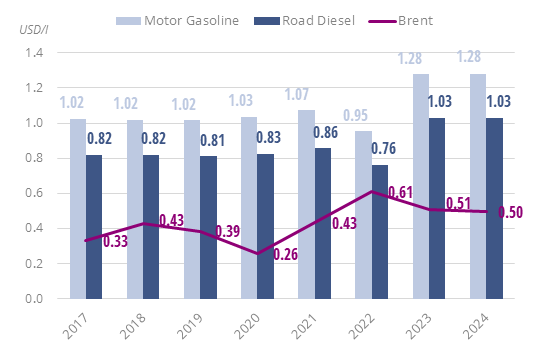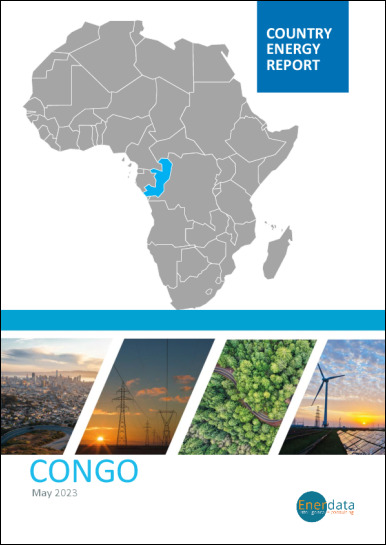- Update
-
- Format
- 3 files (PDF report, 2 Excel files)
- Pages
-
50 (Report only)
- Delivery
- Immediate by e-mail
- GENERAL OVERVIEW
- ENERGY AND CLIMATE POLICY FRAMEWORK
- ENERGY COMPANIES
- ENERGY SUPPLY AND DEMAND
- ENERGY USE AND PRICE BY SECTOR
- ISSUES AND PROSPECTS
- STATISTICS
- ABBREVIATIONS
- GLOSSARY
Buy Congo energy report
Price without VAT. Depending on your statute and location, VAT might be applicable. Get in touch with us for more information.
After validation, you will immediately receive 3 files by email (one pdf report and 2 excel files containing the datasets).
Overview
The Republic of Congo’s energy sector relies heavily on oil and gas, which dominate exports and economic output, while biomass remains the primary domestic energy source. Recent reforms aim to expand gas utilisation, boost renewable capacity—particularly hydropower—and modernise infrastructure, though challenges persist in electrification and reducing flaring. New LNG projects and upstream oil developments signal ambitions to diversify energy exports and attract investment.
Get more details on the table of contents and data files, as well as the list of graphs and tables by browsing the tabs below.
Highlights
- Congo's economy is mainly based on oil and gas revenues.
- Centrale Electrique du Congo and Energie Electrique du Congo account for nearly 70% of the total installed capacity.
- Gas represents 2/3 of power generation.
- The country started exporting LNG in 2024.
- Final energy consumption has remained stable since 2019.
- Biomass is the main energy consumed by final consumers.
- Households and services consumed around three fourths of final energy.
- Several hydropower projects are under development.
- A new plan to enhance the electricity transmission network was launched in July 2025.
Energy & Climate Policy Framework
Congo is located in Sub-Saharan Africa, and is bordered by Gabon, Cameroon, the Central African Republic, and the Democratic Republic of Congo (DRC). Its capital city is called Brazzaville. Its main resources are hydrocarbons, wood, and minerals.
Energy Companies
Oil:
Perenco is the main oil producer (100 kb/d in 2024 (+10%), 36% of total production); it operates the Emeraude, Yombo, Masseko, Likouala, and South PNGF fields. In 2024, the company acquired Eni's shares in various oil fields in the country.
Energy Supply & Demand
Oil:
Oil production increased by 5% in 2023 to 14.3 Mt, after declining by 20% between 2019 and 2022. It rose by 21% in 2018 with the commissioning of several new fields (Moho Nord deep offshore, Lianzi, and Nené Marine).
Energy Use and Price by Sector
Energy Prices in Transport:
Motor fuel prices remained stable in 2024 at 1.28 USD/l for motor gasoline and 1.03UDS/l for road diesel. This followed a sharp increase of nearly 25% in 2022.
Graph: Energy Prices in Transport (Taxes Included)

Issues & Prospects
Oil:
Congo aims to double its crude oil production to 500 kb/d by 2030 compared to 2022 (268 kb/d).
- Graph 1: Primary Consumption Trends by Energy Source
- Graph 2: Total Consumption Market Share by Energy (2023)
- Graph 3: Installed Electric Capacity by Source
- Graph 4: Installed Electric Capacity by Source (2023)
- Graph 5: Gross Power Production by Source & Consumption
- Graph 6: Power Generation by Source (2023)
- Graph 7: Crude Oil Production & Consumption
- Graph 8: Petroleum Products Production & Consumption
- Graph 9: Gas Production & Consumption
- Graph 10: GHG Emissions and CO2-energy Emissions
- Graph 11: Final Demand Trends by Energy Source
- Graph 12: Final Consumption by Sector
- Graph 13: Final Consumption Market Share by Sector (2023)
- Graph 14: Final Consumption in Industry by Energy Source
- Graph 15: Final Consumption in Transport by Energy Source
- Graph 16: Energy Prices in Transport (Taxes Included)
- Graph 17: Final Consumption in Residential, Services, Agriculture by Energy Source
- Graph 18: Upcoming New Capacity by Energy Source
- Economic Indicators: Annual historical data including population, GDP growth, imports and exports, inflation rate, energy security and efficiency indicators, CO2 emissions.
- Supply Indicators: Historical data including oil and gas reserves, electric and refining capacity, energy production, power production and external trade. All are detailed by energy source.
- Demand Indicators: Historical data including consumption per inhabitant, consumption trends, total consumption by energy source, final consumption by energy source and sector, and electricity consumption by sector.
- Energy Balances: Single table displaying the overall energy industry balance per annum, also graphically displayed by energy sub-segment.
The Congo energy market data since 1990 and up to
is included in the Excel file accompanying the Congo country report.
It showcases the historical evolution, allowing users to easily work with the data.
Key Data included in the excelsheet:
- Economic indicators: Annual historical economic indicators, energy security, energy efficiency and CO2 emissions.
- Supply indicators: Annual historical reserves, capacity, production and external trade (imports(+) exports(-) balance).
- Demand indicators: Annual historical consumption per capita, consumption trends, total consumption, final consumption (per energy and per sector) and electricity consumption total and per sector.
- Energy Balance: total and per energy.
- Congo Energy Prices: In addition to the analysis provided on the report we also provided a data set which includes historical details on the Congo energy prices for the follow items: price of premium gasoline (taxes incl.), price of diesel (taxes incl.), price of electricity in industry (taxes incl.), price of electricity for households (taxes incl.), price of natural gas in industry (taxes incl.), prices of natural gas for households (taxes incl.), spot price of Brent and CO2 emissions (from fuel combustion).
 Energy and Climate Databases
Energy and Climate Databases Market Analysis
Market Analysis